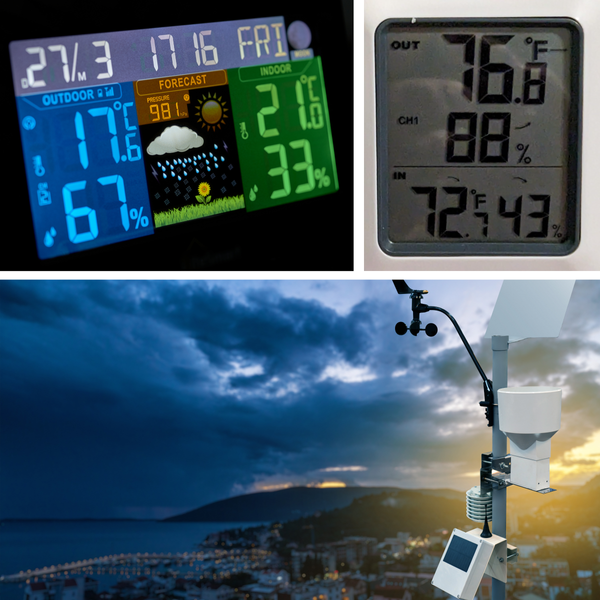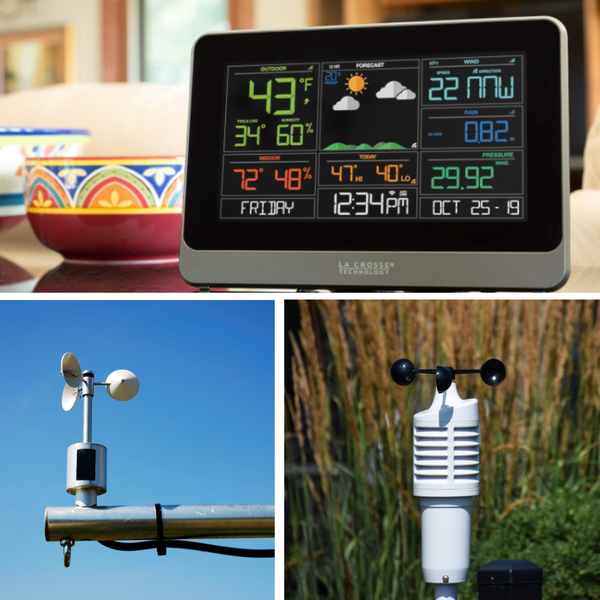Choosing the right weather station for your home can be as crucial as selecting the perfect coffee blend for your morning routine—it needs to be just right! Whether you're a weather enthusiast eager to track every gust of wind or a casual observer interested in occasional updates, finding the best home weather station involves understanding several key factors. This comprehensive guide will walk you through everything you need to know to make an informed decision.
Key Takeaways:
- Understand the different types of sensors and their importance in collecting accurate weather data.
- Consider the installation location and connectivity options for optimal performance.
- Evaluate additional features like data logging and smart home compatibility for enhanced usability.
Understanding Weather Station Types
Weather stations come in various shapes and sizes, each designed to cater to specific needs. Most weather stations include basic sensors for measuring temperature, humidity, and barometric pressure. However, more advanced models might also measure wind speed and direction, rain, solar radiation, and more. Deciding on the complexity of the weather station often depends on your level of interest and how you plan to use the weather data.

Sensor Essentials
At the heart of any weather station are its sensors. These devices collect weather data crucial for accurate forecasting. Key sensors include temperature sensors, humidity sensors, and barometric pressure sensors. For more detailed data, look for stations with rain gauges to measure rainfall, anemometers for wind speed, and wind vanes for wind direction.
Choosing the Right Location
The location of your weather station significantly affects its accuracy. To avoid errors in temperature readings due to direct sunlight, it's essential to place sensors in a shaded area. Similarly, wind sensors should be placed at a higher point, free from obstructions to measure wind speed and direction accurately.
Connectivity and Power Options
Modern weather stations offer various connectivity options, including Wi-Fi and other forms of internet connectivity, allowing for remote access to weather data. This feature is particularly useful for uploading data to weather platforms like Weather Underground. Additionally, consider the power supply for your station—solar-powered units can reduce battery replacement costs and are environmentally friendly.

Data Logging and Accessibility
One of the perks of owning a personal weather station is having access to historical weather data. This data can help you observe weather trends and make predictions based on previous weather data. Ensure the station has ample storage or offers cloud storage solutions for data logging.
Integration with Smart Home Devices
For those who embrace smart home technology, integrating your weather station with other smart home devices can enhance your home's automation. For example, connecting your station to smart irrigation systems can help optimize watering schedules based on soil moisture and recent rainfall.
Display Units and User Interface
The display console of your weather station should be user-friendly, offering clear and immediate access to weather information. Some stations come with a colorful display or a larger display, making it easier to read at a glance. Consider the layout and the type of information displayed to ensure it meets your needs.

Optimizing Weather Station Placement
When setting up a weather station at home, the placement of both the sensor array and the station location can make or break the accuracy of the data collected. For the most accurate readings, it's crucial to consider factors like elevation, obstructions, and exposure. Ideally, sensors should be placed at a standard height above the ground, away from any artificial heat sources or reflective surfaces, which can skew temperature sensor readings. This ensures that factors such as wind chill and heat index are measured under the most representative conditions.
Moreover, the transmission range between the outdoor sensors and the indoor console is vital for maintaining data quality. Obstacles like thick walls or large trees can interfere with the signal, leading to loss of data or inaccurate readings. To avoid these issues, ensure there is a clear path between these components. Some of the best home weather stations have robust transmission capabilities that can handle longer distances and various interferences, ensuring that your weather forecasting remains precise and reliable.
The Role of Rain Gauges in Home Weather Stations
Rain gauges are a pivotal component of home weather stations, especially for those who love to keep a close eye on precipitation patterns. These meteorological instruments measure how much rain has fallen over a specific period, providing invaluable data for gardening, planning outdoor activities, or simply understanding local weather trends. By tracking rainfall, homeowners can make informed decisions about water usage and lawn care, contributing to more sustainable living practices.
Moreover, integrating a rain gauge with other sensors enhances the overall accuracy of your home weather station. It allows you to compare your data with local news reports or professional forecasts, ensuring that your weather predictions are as precise as possible. This comparison not only validates your equipment but also deepens your understanding of how weather systems affect your immediate environment. Whether it's a drizzle or a downpour, your rain gauge keeps you informed and prepared.

Dew Point and Relative Humidity: Understanding Their Importance
Dew point and relative humidity are critical indicators of atmospheric moisture, and understanding them can significantly improve your ability to predict local weather conditions. The dew point is the temperature at which air becomes saturated with moisture and begins to condense into dew. This measurement is crucial for predicting fog and dew formation, which can impact driving conditions and plant health. A weather station that measures dew point provides a clearer picture of how moist or dry the air around your home is.
Relative humidity, on the other hand, expresses the current amount of moisture in the air as a percentage of the maximum moisture the air can hold at that temperature. High relative humidity can make temperatures feel warmer than they actually are, while low humidity can cause discomfort and respiratory issues. By monitoring both dew point and relative humidity, your indoor display unit can offer more detailed and useful weather forecasts, helping you to plan your day with greater confidence and comfort.
Understanding Weather Data Analysis
For weather enthusiasts who love to dive deep into meteorological analysis, choosing a weather station that stores historical weather data is essential. This feature allows you to track temperatures, measure rainfall, and monitor changes in air pressure over time, providing a comprehensive view of weather patterns. By analyzing historical data, you can make more informed predictions and understand how weather trends evolve.
Additionally, many advanced personal weather stations offer the capability to upload data to a weather app or integrate with online weather communities. This not only allows you to compare your data with other weather stations but also contributes to broader meteorological studies. By sharing and comparing data, you can enhance your understanding of local and global weather phenomena, such as tracking lightning strikes or monitoring the frequency of wind gusts, enriching your overall weather tracking experience.

Additional Features to Consider
Beyond the basics, some weather stations offer features like lightning strike detection, solar sensors, and additional sensors for measuring parameters like soil moisture. These features can be particularly appealing to gardening enthusiasts or those living in areas prone to severe weather.
Weather Station Maintenance
Maintaining your weather station is crucial for ensuring long-term accuracy and reliability. Regularly check and clean the sensors, especially after extreme weather conditions. Also, check the battery backup systems to ensure they are functioning correctly in case of a power outage.
Budget Considerations
Weather stations can range from affordable basic models to high-end stations with extensive features. Set a budget early in your shopping process and compare the features available within your price range. Remember, investing a bit more upfront can sometimes save you from future headaches with cheaper, less reliable models.

Summary
Choosing the right weather station involves a careful consideration of the types of weather data you wish to collect, the station's location, connectivity options, and additional features that enhance functionality and ease of use. By understanding these elements, you can select a weather station that not only meets your needs but also turns weather tracking into a seamless and enjoyable activity.
FAQ
What is the best weather station for home use?
The best weather station for home use depends on your specific needs. Models like the Davis Instruments Vantage Vue and Ambient Weather WS are highly regarded for their accuracy and reliability.
How do I ensure my weather station gives accurate data?
To ensure accuracy, install your sensors in locations that reflect true environmental conditions, away from artificial heat sources or obstructions. Regular maintenance and calibration are also crucial.
Can I connect my weather station to my smartphone?
Yes, many modern weather stations are equipped with Wi-Fi or other forms of connectivity that allow you to view and manage your weather data via a smartphone app. This feature is great for on-the-go monitoring and data sharing.










